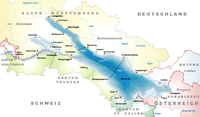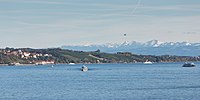
The canton of Schaffhausen, also canton of Schaffhouse, is the northernmost canton of Switzerland. The principal city and capital of the canton is Schaffhausen. The canton's territory is divided into three non-contiguous segments, where German territory reaches the Rhine. The large central part, which includes the capital, in turn separates the German exclave of Büsingen am Hochrhein from the rest of Germany.

A maar is a broad, low-relief volcanic crater caused by a phreatomagmatic eruption. A maar characteristically fills with water to form a relatively shallow crater lake, which may also be called a maar.
Singen is an industrial city in the very south of Baden-Württemberg in southern Germany and just north of the German-Swiss border.

Aach is a small town in the German state of Baden-Württemberg. Being situated close to Lake Constance and the Swiss border, it is mostly known for the Aachtopf — Germany's biggest natural spring in terms of production. The town was originally twinned with the region of Colmnitz, but following the integration of Colmnitz into Klingenberg, Saxony the town is now twinned with Klingenberg itself.

48.473°N 8.003°E

Hohentwiel is a mountain of volcanic origin in the Hegau region of Baden-Württemberg in southern Germany, located west of the industrial city of Singen and ca 10 km (6.2 mi) west of Zeller See. The ruins of the medieval Hohentwiel Castle rest on top of it.
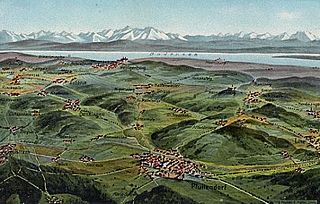
Linzgau is a historic region in Southern Germany, in the state of Baden-Württemberg. It is located north of Lake Constance and south of the Danube valley.

The High Rhine Railway is a Deutsche Bahn railway line from Basel Badischer Bahnhof in the city of Basel to Konstanz on Lake Constance. It was built by the Grand Duchy of Baden State Railways as part of the Baden Mainline, which follows the Rhine upstream from Mannheim Hauptbahnhof to Konstanz. The line derives its name from the High Rhine, which it follows between Basel and Waldshut and on a short section in Schaffhausen.

The Volcanic Eifel or Vulkan Eifel, also known as the East Eifel Volcanic Field (EEVF), is a region in the Eifel Mountains in Germany that is defined to a large extent by its volcanic geological history. Characteristic of this volcanic field are its typical explosion crater lakes or maars, and numerous other signs of volcanic activity such as volcanic tuffs, lava streams and volcanic craters like the Laacher See. The Volcanic Eifel is still volcanically active today. One sign of this activity is the escaping gases in the Laacher See.

Blauer Stein is a mountain of volcanic origin in the Hegau region (Schwarzwald-Baar) of southern Baden-Württemberg, Germany. It is located near the village of Randen (Blumberg).

Hegau-Gymnasium is a gymnasium in Singen in the very south of Baden-Württemberg in southern Germany. The school is named after the extinct Hegau volcanic landscape.
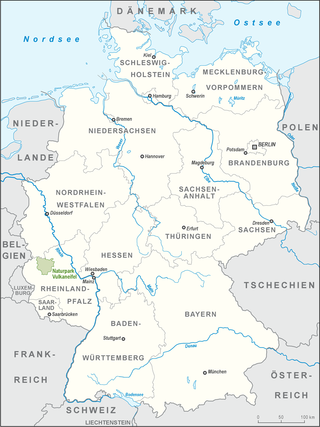
The Volcanic Eifel Nature Park lies in the counties of Bernkastel-Wittlich, Cochem-Zell and Vulkaneifel in the German state of Rhineland-Palatinate. The nature park, which is in the Eifel mountains, and which is also a geopark, was inaugurated on 31 May 2010 and has an area of 1,068.24 km2.> Its sponsor is the Natur- und Geopark Vulkaneifel GmbH.

Singen (Hohentwiel) station is an important regional railway junction and interchange station in the town of Singen in the south of the German state of Baden-Württemberg. Three railways now meet there, but in the past five railways connected to it. The station is served by InterCity trains on the Stuttgart–Zurich route.

The Rockeskyller Kopf near Rockeskyll in the county of Vulkaneifel in the German state of Rhineland-Palatinate is a hill, 554.6 m above sea level (NHN), in the Eifel mountains. It is an extinct volcano complex from the Quaternary period, around 360,000 years old and is designated as a natural monument (ND-7233-420).

Bolshaya Ipelka is a massive shield volcano at the southern end of the Kamchatka Peninsula in Russia's Far East region. It represents the largest volcanic structure of southern Kamchatka Krai, covering an area measuring 32 km (20 mi) long and 42 km (26 mi) wide. Bolshaya Ipelka is of Pleistocene age and formed west of the main volcanic zone in southern Kamchatka. The shield volcano is now inactive, having last erupted during the Pleistocene epoch.
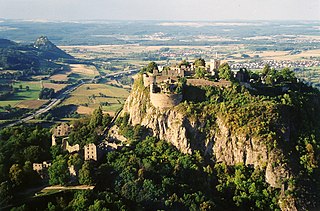
Hohentwiel Castle is a ruin of a former castle on the peak of the dead volcano Hohentwiel. It is located in the region called Hegau, which is close to the Lake of Constance. The mountain overtowers the city of Singen, which is located on the foot of the mountain, by 260 meters. With an overall area of nine hectares, Hohentwiel castle is the biggest castle ruin in Germany which is open for tourists. Since 1990, more than 80,000 tourists have visited the ruin every year; the maximum was reached in 2002 when 126,500 people visited Hohentwiel castle. The annual Hohentwiel-Festival takes place in the fortress area.

Steirisches Vulkanland is an extinct volcanic field located in the Austrian state of Styria which maintained activity between 15 ma–2 ma ago, its last activity being in the Gleichenberg Kögel in Burgenland, currently the remnants of this volcanic field are the Hills, Maars and Diatremes.

The Schaffhausen S-Bahn is an S-Bahn network in the Swiss canton of Schaffhausen and the German state of Baden-Württemberg. It comprises three services and began operation in 2015. Services are operated by SBB GmbH, Swiss Federal Railways' German subsidiary, and THURBO.
The Etzwilen to Singen railway is a heritage railway between Etzwilen in the Swiss canton of Thurgau and Singen in the German state of Baden-Württemberg, crossing the eastern part of the canton of Schaffhausen. Passenger train services existed between 1875 and 1969, while cargo trains operated the line until 2004. Today, it is used by heritage trains and draisines.




























